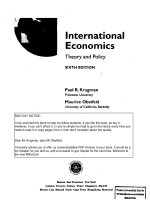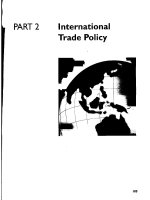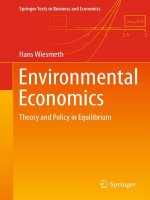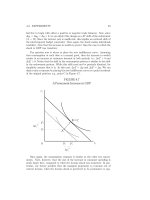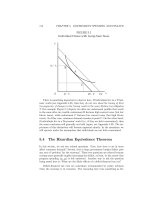Environmental Economics: Theory and Policy in Equilibrium ppt
Bạn đang xem bản rút gọn của tài liệu. Xem và tải ngay bản đầy đủ của tài liệu tại đây (3.29 MB, 328 trang )
Springer Texts in Business and Economics
For further volumes:
/>
Hans Wiesmeth
Environmental Economics
Theory and Policy in Equilibrium
With Contributions by Judith Marquardt
ISBN 978-3-642-24513-8 e-ISBN 978-3-642-24514-5
DOI 10.1007/978-3-642-24514-5
Springer Heidelberg Dordrecht London New York
Library of Congress Control Number: 2011940769
pringer-Verlag Berlin Heidelberg 201
This work is subject to copyright. All rights are reserved, whether the whole or part of the material is
concerned, specifically the rights of translation, reprinting, reuse of illustrations, recitation,
broadcasting, reproduction on microfilm or in any other way, and storage in data banks. Duplication
of this publication or parts thereof is permitted only under the provisions of the German Copyright
Law of September 9, 1965, in its current version, and permission for use must always be obtained
from Springer. Violations are liable to prosecution under the German Copyright Law.
The use of general descriptive names, registered names, trademarks, etc. in this publication does not
imply, even in the absence of a specific statement, that such names are exempt from the relevant
protective laws and regulations and therefore free for general use.
Printed on acid-free paper
Springer is part of Springer Science+Business Media (www.springer.com)
© S 2
ISSN 2192-4333 e-ISSN 2192-4341
Dr.Prof. Hans Wiesmeth
TU Dresden
Faculty of Business and Economics
Chair of Economics, esp. Allocation
Theory
01062 Dresden
Germany
Preface
This monograph is an “offspring” of an earlier textbook on Environmental Eco-
nomics which was published in 2002. It is, however, not just an update or a simple
translation of the former German version. Rather, this book includes topics, which
played no significant role in public opinion some 10 years ago.
Climate change is one of the cross-border environmental issues which has sub-
stantially gained importance and public attention over the last decade. From a theo-
retical point of view, tackling this issue amounts to solving the allocation problems
for a global environmental commodity. As long as there are no straightforward and
functioning “global” allocation mechanisms, this will remain a challenge for in-
ternational environmental policy. The text addresses this issue in various chapters
and sections, which each have a different focus. Of course, international efforts to
curb greenhouse gas emissions, the various cap and trade policies, for example, are
included in this analysis together with critical assessments.
Overfishing has been on the agenda of national and international organizations
for decades. However, the increasing globalization accompanied by technological
innovations and rising demand seems to exacerbate the alarmingly poor state of
the world’s marine stocks. As is the case for climate change, there is no promising
multinational policy on the horizon to date. The text therefore retains this issue
from the former book with some additional information and analysis related to the
international context.
Integrated approaches to environmental policy such as integrated waste man-
agement in general and policies for waste electrical and electronic equipment in
particular consider “waste” as part of the allocation problems. Therefore, the three
“R”s, reducing waste, reusing or recycling discarded commodities, have to be rea-
sonably implemented in a practical context. This requires a holistic approach, inte-
grating appropriate signals from all stages of a product’s life span, including design
and the post-consumption phase. Extended producer responsibility is meant to pro-
vide incentives for a design for environment, and is introduced into the text together
with integrated waste management and policies for waste electrical and electronic
equipment.
v
vi Preface
Holistic environmental policy is also used for promoting renewable energy
sources. These approaches rely upon appropriate framework conditions by open-
ing investment opportunities for private business – a special public-private partner-
ship with the public authorities establishing the required framework conditions. The
book addresses this issue and discusses examples of this kind of a Private Finance
Initiative.
Of course, the monograph presents and analyzes the standard theoretical tools
which are required for environmental economics, although resource economics is
not included in the text, beyond the issue of overfishing. Classical instruments of
environmental policy are also discussed, always with a link to theory.
It is, generally speaking, one of the characteristics of this monograph to thor-
oughly analyze practical environmental issues with theoretical tools which are of-
ten taken from equilibrium analysis, although in various situations, especially in
an international context, the market mechanism has to be replaced by some other
allocation mechanism – negotiations, for example. These two hallmarks then jus-
tify the title of the monograph: “Environmental Economics – Theory and Policy in
Equilibrium”, and the text was written with this concept in mind.
This textbook is suitable for undergraduate and graduate courses on theoretical
and applied environmental economics. The material in Part II and Part IV is, how-
ever, more demanding from a formal point of view, and addresses readers, who are
familiar with microeconomics on at least an intermediate level. The various cases
included in the text provide sufficient material for discussions in class.
This textbook owes a great deal to many people. Undergraduate and graduate
students, and research associates at Dresden University of Technology, Hanoi Uni-
versity of Science and International School of Economics at Tbilisi State University
have played an important part in the development and further development of this
text. I am indebted to my colleagues Bernd Bilitewski from Dresden University
of Technology and Martin Wittmaier from Bremen University of Applied Sciences,
who introduced me to the exciting world of waste management and drew my in-
terest to many policy issues in this area. The editors at Springer, Barbara Fess and
Marion Kreisel, were quite helpful in providing technical assistance. Finally, I am
very grateful to my former colleague, Judith Marquardt, who, as native speaker,
proofread and provided further helpful advice regarding international aspects.
Dresden,
September 2011 Hans Wiesmeth
Contents
1 Introduction 1
1.1 Ecology and Economy: Unequal Partners? . . . 1
1.1.1 Environmental Economics . 3
1.1.2 Why is Theory Needed for Environmental Policy? . . . 4
1.2 Survey of the Book 5
References . . 9
Part I The Environmental Movement
2 Differing Views on the Environment 13
2.1 The Europeans and the Environment 13
2.1.1 Environmental Awareness in Europe . 14
2.1.2 Conclusions for Environmental Economics . 15
2.2 The Environmental Movement in the US 17
2.3 The Developing World and the Environment . 20
2.3.1 China and the Environment 20
2.3.2 India and the Environment 22
2.4 Attitudes Towards the Environment: A Summary . . 23
References . . 24
3 The International Dimension of the Environment 27
3.1 International Environmental Issues 27
3.1.1 Global Environmental Commodities . 27
3.1.2 Consequences of Globalization . . 29
3.1.3 The Environment and International Trade . . 30
3.2 International Conferences and Environmental Agreements . . . 31
3.2.1 The United Nations Conference on Environment and
Development (UNCED) . . 31
3.2.2 The United Nations Framework Convention on Climate
Change (UNFCCC) . 36
3.2.3 The Kyoto Protocol . 37
vii
viii Contents
3.2.4 Copenhagen, Cancun, Durban and Rio? . . . 39
References . . 41
Part II Theoretical Environmental Economics
4 Basics of Environmental Economics 45
4.1 Fundamental Concepts . 45
4.1.1 Environmental Awareness and Perceived Scarcity 45
4.1.2 Environmental Commodities and Allocation Problems 47
4.2 Efficiency as a Normative Criterion for Environmental Economics . 48
4.2.1 Economic Efficiency and the Environment: Theory . . . 49
4.2.2 Economic Efficiency and the Environment: Applications . . . 50
References . . 52
5 Allocation Problems in a Market Economy 53
5.1 Efficient Equilibrium Allocations . 53
5.1.1 The Model Economy 53
5.1.2 Market Equilibrium . 56
5.2 Environmental Effects in a Market Economy . 59
5.2.1 The Concept of an External Effect . . . 59
5.2.2 Analysis of an Externality . 61
5.2.3 Market Equilibrium with External Effects . . 63
5.3 Public Commodities in Environmental Economics . 66
5.3.1 The Prisoners’ Dilemma in an Environmental Context 67
5.3.2 The Prisoners’ Dilemma and the Kyoto Protocol 70
5.3.3 The Tragedy of the Commons. . . 74
References . . 75
6 The Internalization of External Effects 77
6.1 External Effects and Missing Markets . 77
6.1.1 Supplementing the Market System . . . 79
6.2 The Pigou Tax . . . 83
6.3 Firm-Specific Prices for an Environmental Commodity . 87
6.4 Tradeable Emission Certificates . . . 89
6.5 Pollution Rights . . 91
6.6 The Coase Theorem . . . 98
References . . 101
7 Public Goods in Environmental Economics 103
7.1 The Lindahl Mechanism 103
7.1.1 The Concept of a Lindahl Equilibrium 103
7.1.2 Lindahl Equilibrium and Incentive Compatibility 106
7.2 Core Equivalence in a Public Goods Economy 108
7.2.1 The Core of an Economy with a Public Good . . . 108
7.2.2 The Cost-Share Equilibrium 111
7.2.3 Core Equivalence and Cost-Share Equilibria 114
Contents ix
7.3 Implications for the Kyoto Protocol 117
References . . 122
Part III Environmental Policy
8 From Theory to Policy: Information Deficits 127
8.1 Informational Requirements Regarding the Structure of the Markets 127
8.1.1 The Competition-Price Mechanism . . 129
8.2 Information Deficits in International Environmental Policy . . . 131
8.3 Information Deficits Regarding Hazardous Materials and Processes 132
8.4 Consequences for Environmental Policy 134
References . . 136
9 Command-and-Control Policy 139
9.1 Environmental Standards and Framework Conditions . . 139
9.1.1 Standards in Economic Systems . 140
9.1.2 Ecological Efficiency of Standards: Examples . . 141
9.1.3 Framework Conditions, Standards and the Private Finance
Initiative . 142
9.2 The Refillables Quota Issue . 143
9.2.1 Facts and Developments Regarding Refillable Packaging . . . 144
9.2.2 The Refillables Quota Issue and the German Packaging
Ordinance 147
9.3 Economic Feasibility of an Environmental Policy . . 149
9.3.1 The Concept of Economic Feasibility 149
9.3.2 Economic Feasibility: A Formal Analysis . . 150
9.3.3 Economic Feasibility in a Practical Context 156
References . . 157
10 Integrated Approaches to Environmental Policy 159
10.1 Extended Producer Responsibility (EPR) 159
10.1.1 General Aspects of Waste Electrical and Electronic
Equipment (WEEE) . 160
10.1.2 EPR Approach to WEEE in Germany 163
10.1.3 EPR Approach to WEEE in Japan . . . 165
10.2 Integrated Waste Management (IWM) . 167
10.2.1 The Concept of IWM in Environmental Economics . . . 168
10.2.2 The Implementation of IWM . . . 169
10.2.3 IWM in Germany . . . 173
10.3 Renewable Energy Sources . 175
10.3.1 The German Renewable Energy Sources Act (EEG) . . 176
10.3.2 The EEG in Practice . 177
10.4 Integrated Approaches: A Summary . . . 179
References . . 180
x Contents
11 The Price-Standard Approach to Environmental Policy 183
11.1 Market-Oriented Environmental Policies 183
11.2 Pollution Tax 185
11.2.1 Relevant Features of the Pollution Tax 185
11.2.2 Cost Efficiency of the Pollution Tax . . 187
11.2.3 Cost Efficiency with Spatial Differentiation 189
11.3 Ecotaxes 191
11.3.1 Aspects of an Ecotax 191
11.3.2 Theoretical Considerations Regarding an Ecotax 192
11.3.3 The Ecological Tax Reform in Germany . . . 193
11.4 Tradeable Emission Certificates. . . 195
11.4.1 Relevant Features of Markets for Tradeable Certificates . . . . 195
11.4.2 Emission-Oriented and Immission-Oriented Trading
Schemes. . 196
11.5 Experiences with Markets for Tradeable Certificates . . . 199
11.5.1 The EU Emission Trading System (EU ETS) . . . 199
11.5.2 A Critical Assessment of the EU ETS 202
11.5.3 The US Cap and Trade Policy . . . 203
11.5.4 Cap and Trade Policies in Other Parts of the World . . . 207
References . . 208
12 The Allocation of International Environmental Commodities 211
12.1 International Environmental Agreements 211
12.2 The Principal-Agent Problem in Environmental Policy . 213
12.2.1 Stability and Efficient Mitigation Strategies 214
12.2.2 The Role of Adaptation Strategies . . . 219
References . . 225
Part IV The Environment in the Globalized World
13 Trade and the Environment: The Legal Context 229
13.1 The Framework Conditions for International Trade 229
13.2 Environmental Aspects of the GATT and the WTO 231
13.3 Regional Trade Agreements . 235
13.3.1 The Environmental Policy of the EU . 235
13.3.2 The North American Free Trade Agreement (NAFTA) 237
13.4 Consequences for the Integration of Trade and the Environment . . . . 240
References . . 242
14 Overfishing 245
14.1 The State of Fishery Resources . . . 245
14.2 Short-Run Supply of the Fisheries . 247
14.2.1 Interdependence of Fisheries 248
14.2.2 Short-Run Supply and Fixed-Stock Equilibrium 250
14.3 Integration of Economical and Biological Aspects . 254
14.3.1 A Biological Growth Process . . . 254
Contents xi
14.3.2 The Bioeconomic Equilibrium . . 255
14.4 The Market Equilibrium 259
14.5 Conclusions from the Formal Analysis . . 262
14.5.1 An Analysis of Externalities in the Fishing Industry . . 263
14.5.2 Attempts to Internalize Externalities in Fisheries 264
14.5.3 Quota Management Systems 265
14.6 Fisheries Policies . 268
14.6.1 Subsidies and Overcapacity in the Fishing Industry . . . 268
14.6.2 Evaluating the Common Fisheries Policy of the EU. . . 271
14.6.3 A Glance at the US Fisheries Policy . 274
14.7 Overfishing: A Summary . . . 277
References . . 278
15 Integration of Trade and the Environment 281
15.1 Bhagwati’s “Genuine Problems” . . 281
15.2 Trade and the Environment: A Formal Approach . . 283
15.2.1 The Model 283
15.2.2 Autarky Equilibrium 287
15.2.3 Free Trade Equilibrium . . . 289
15.3 Trade and the Environment: The Formal Integration 292
15.3.1 From Autarky to Free Trade 292
15.3.2 Harmonizing Environmental Standards 293
15.4 Regulation . . 295
15.5 Stackelberg Equilibrium 297
15.6 Integrating Trade and the Environment: A Summary . . . 300
References . . 300
Index 303
List of Figures
5.1 (Theory) Aggregate supply set without external effects. . 54
5.2 (Theory) Market equilibrium without external effects . . . 58
5.3 (Theory) Market equilibrium with external effects – Example A . . . . 62
5.4 (Theory) Market equilibrium with external effects – Example B . . . . 62
6.1 (Theory) Marginal social cost of pollution – Example A. 85
6.2 (Theory) Marginal social cost of pollution – Example B . 86
6.3 (Theory) Property rights assigned to one sector – Example A . 93
6.4 (Theory) Property rights assigned to one sector – Example B . 96
7.1 (Theory) Core equivalence for cost-share equilibria 115
8.1 (Policy) The competition-price mechanism. . . 129
9.1 (Economic Viability of Recycling) Case without recycling 151
9.2 (Economic Viability of Recycling) Case with recycling . 153
11.1 (Policy) Offset system with several control points and emission
sources . 198
12.1 (Principal-Agent Approach) Raising environmental awareness 217
12.2 (Principal-Agent Approach) Effect of adaptation . . . 223
12.3 (Principal-Agent Approach) Effect of adaptation (details) 224
14.1 (Fishery) Global trends in the state of world marine stocks . . . 246
14.2 (Fishery) Reaction curves and fixed-stock equilibrium . . 250
14.3 (Fishery) Equilibrium output and the efficiency parameters . . . 252
14.4 (Fishery) Sustainable catch for various levels of the resource stock . . 255
14.5 (Fishery) Bioeconomic equilibrium 256
14.6 (Fishery) Stability of the bioeconomic equilibrium . 257
14.7 (Fishery) Efficiency parameters affecting the bioeconomic
equilibrium . . . 258
xiii
xiv List of Figures
14.8 (Fishery) Efficiency parameters affecting aggregate supply, case 1 . . 259
14.9 (Fishery) Efficiency parameters affecting aggregate supply, case 2 . . 260
14.10 (Fishery) Increasing market demand affecting equilibrium 261
14.11 (Fishery) Efficiency parameters affecting equilibrium . . . 262
14.12 (Fishery) Optimal allocation of quota . . . 267
15.1 (Nash Equilibrium) Structure of a game – simultaneous decisions. . . 285
15.2 (Trade and Environment) Autarky equilibrium with international
environmental effects . . . 288
15.3 (Trade and Environment) Free trade equilibrium with regional
environmental effects . . . 290
15.4 (Trade and Environment) Free trade equilibrium with international
environmental effects . . . 291
15.5 (Harmonization) Free trade and regional environmental effects 294
15.6 (Harmonization) Free trade and international environmental effects . 295
15.7 (Nash Equilibrium) Structure of a game – sequential decisions 297
15.8 (Stackelberg Equilibrium) Autarky with international
environmental effects . . . 298
15.9 (Stackelberg Equilibrium) Free trade with international
environmental effects . . . 299
List of Tables
5.1 (Theory) Example of a Prisoners’ Dilemma situation 69
5.2 (Kyoto Protocol) Target reductions and 2008 reductions of CO
2
emissions according to IEA and UNFCCC reports . . 71
9.1 (Waste Management) Quota of reusable and ecologically
advantageous one-way drinks packaging in Germany (2007-2009) . . 144
9.2 (Waste Management) Container mix for soft drinks in the US
(1947-1998) . . 145
9.3 (Waste Management) Quota of reusable drinks packaging in
Germany (1991-2009) . . 147
10.1 (Waste Management) Packaging consumption in Germany
(1991-2006) . . 174
11.1 (EU ETS) Carbon allowances for various member states of the EU . . 201
xv
Acronyms
APS Ambient Permit System
CAA US Clean Air Act
CAIR US Clean Air Interstate Rule
CCS Carbon Capture and Storage
CEE Central and Eastern Europe
CER Certified Emission Reduction
CFC Chlorofluorocarbon
CFP EU Common Fisheries Policy
COP Conference of the Parties
CO
2
Carbon Dioxide
CPRS Australian Carbon Pollution Reduction Scheme
CTE Committee on Trade and Environment
DfE Design for Environment
DIW German Institute for Economic Research
DM Deutsche Mark
EAP European Community Environment Action Programme
EC European Commission
ECSC European Coal and Steel Community
EEC European Economic Community
EEG German Renewable Energy Sources Act
EEZ Exclusive Economic Zone
EFF European Fisheries Fund
ElektroG German Electrical and Electronic Equipment Act
EPA US Environmental Protection Agency
EPR Extended Producer Responsibility
EPS Emissions Permit System
ERU Emission Reduction Unit
EU European Union
EU ETS European Union Greenhouse Gas Emission Trading System
FCMA US Fishery Conservation and Management Act
FDA US Food and Drug Administration
xvii
xviii Acronyms
FIFG EU Financial Instrument for Fisheries Guidance
FRG Federal Republic of Germany
GATT General Agreement on Tariffs and Trade
GATS General Agreement on Trade in Services
GDP Gross Domestic Product
GDR German Democratic Republic
GIZ German Agency for International Cooperation
GNP Gross National Product
GTZ German Technical Cooperation Agency
GW Gigawatt
HARL Japanese Home Appliance Recycling Law
IARI Indian Agricultural Research Institute
IEA International Energy Agency
IMF International Monetary Fund
IPA EU Instrument for Pre-Accession Assistance
IPCC Intergovernmental Panel on Climate Change
IWM Integrated Waste Management
IUU Illegal, Unreported and Unregulated Fishing
kWh Kilowatthour
MEA Multilateral Environmental Agreement
MERC USAID Middle East Regional Cooperation Program
MRS Marginal Rate of Substitution
MRT Marginal Rate of Transformation
MSW Municipal Solid Waste
MWh Megawatthour
NAFTA North American Free Trade Agreement
NMFS US National Marine Fisheries Service
NOAA US National Oceanic and Atmospheric Administration
OECD Organization for Economic Cooperation and Development
PFI The Private Finance Initiative
PPP Public-Private Partnership
RAC EU Regional Advisory Council
RTA Regional Trade Agreement
SEA EU Single European Act
SO
2
Sulfur Dioxide
TAC Fisheries: Total Allowable Catch
TRIPS Agreement on Trade-Related Aspects of Intellectual Property Rights
UBA German Federal Environmental Agency
UNCED United Nations Conference on Environment and Development
UNECE United Nations Economic Commission for Europe
UNEP United Nations Environment Programme
UNFCCC United Nations Framework Convention on Climate Change
US United States of America
USAID United States Agency for International Development
USDA US Department of Agriculture
Acronyms xix
WEEE Waste Electrical and Electronic Equipment
WTO World Trade Organization
WWF World Wildlife Fund
Chapter 1
Introduction
Abstract This introductory chapter raises first the seemingly delicate issue of ad-
dressing environmental issues with economic tools and instruments. After all, envi-
ronmental degradations are to some extent the result of economic activities, and a
contradiction between economy and ecology seems to be obvious. Thereafter, the
role of economic theory is explained together with a deeper analysis of the equi-
librium approach to environmental economics. The need for appropriate allocation
mechanisms, both on a national and an international level, to tackle environmental
problems, will be discussed before a survey reveals the structure of this monograph.
1.1 Ecology and Economy: Unequal Partners?
An economic imperative in the form of a potential loss of international competitive-
ness with ensuing higher unemployment rates has often been cited by well-known
representatives of the private sector to argue against the implementation of higher
environmental standards. Conversely, rigorous environmentalists point to the in-
creasing scarcity of environmental resources, which are of utmost importance for
practically all economic activities. Therefore, the protection of the environment has
to take absolute precedence over further economic progress.
This apparent dichotomy between ecology and economy is, without doubt, of
substantial relevance for the further economic and social development of all parts
of the world. Unfortunately, as the above statements make clear, ecology and econ-
omy are not independent of each other. On the contrary, they are closely linked
and intertwined. This fact has been recognized and clearly stated by the Brundtland
Commission, formally the World Commission on Environment and Development,
which was established by the UN in 1983 in view of the increasing role of global
environmental issues. The commission is named after its chairperson Gro Harlem
Brundtland, a longtime Prime Minister of Norway. In her foreword to the famous
report of the commission, also called the Brundtland Report and published in 1987,
,
1
DOI 10.1007/978-3-642-24514-5_1,
© Springer-Verlag Berlin Heidelberg 2012
H. Wi smeth, Environmental Economics: Theory and Policy in Equilibrium
Springer Texts in Business and Economics,
e
2 1 Introduction
Gro Harlem Brundtland points to this inseparable relationship between environment
and development:
Our Common Future
Report of the World Commission on Environment and Development
(excerpt from [1], Chairman’s Foreword)
When the terms of reference of our Commission were originally being dis-
cussed in 1982, there were those who wanted its considerations to be lim-
ited to “environmental issues” only. This would have been a grave mistake.
The environment does not exist as a sphere separate from human actions,
ambitions, and needs, and attempts to defend it in isolation from human
concerns have given the very word “environment” a connotation of naivety
in some political circles. The word “development” has also been narrowed by
some into a very limited focus, along the lines of “what poor nations should
do to become richer”, and thus again is automatically dismissed by many in
the international arena as being a concern of specialists, of those involved
in questions of “development assistance”.
But the “environment” is where we all live; and “development” is what we all
do in attempting to improve our lot within that abode. The two are insepa-
rable. Further, development issues must be seen as crucial by the political
leaders who feel that their countries have reached a plateau towards which
other nations must strive. Many of the development paths of the industri-
alized nations are clearly unsustainable. And the development decisions of
these countries, because of their great economic and political power, will
have a profound effect upon the ability of all peoples to sustain human
progress for generations to come.
Later in this report, the commission introduced the concept of sustainable develop-
ment, which thereafter gained widespread acceptance and was introduced into the
economic and environmental literature:
Our Common Future
Report of the World Commission on Environment and Development
(excerpt from [1], Ch. 2)
Sustainable development is development that meets the needs of the present
without compromising the ability of future generations to meet their own
needs. It contains within it two key concepts:
• the concept of ‘needs’, in particular the essential needs of the world’s
poor, to which overriding prior ity should be given; and
1.1 Ecology and Economy: Unequal Partners? 3
• the idea of limitations imposed by the state of technology and social or-
ganization on the environment’s ability to meet present and future needs.
Thus the goals of economic and social development must be defined in
terms of sustainability in all countries – developed or developing, market-
oriented or centrally planned. Interpretations will var y, but must share certain
general features and must flow from a consensus on the basic concept of
sustainable development and on a broad strategic framework for achieving
it.
Therefore, ecology and economy are integrated and should not be torn apart. It re-
mains true, of course, that what could be called environmental awareness is of dif-
ferent relevance in different countries. Developing countries with high growth rates
seem to be less interested in environmental issues than industrialized countries. On
the other hand, the ecological footprint of a citizen of an industrialized country ex-
ceeds that of a citizen of a developing country by far. But then again, a richer society
has the means to address pollution of the environment and, even more important, to
prevent or reduce further pollution.
What is then the role of environmental economics in this context? The answer to
this question will be explored in the following subsection.
1.1.1 Environmental Economics
Once the intrinsic relationship between the economy and the environment is ac-
cepted, the role of environmental economics is (almost) straightforwardly deter-
mined by the concept of environmental commodities, which helps to “embed” en-
vironmental issues into the economic framework. The term “commodity” refers to
the fact that the environment with its multitude of characteristics affects the well-
being of mankind directly and indirectly, similarly to “regular” commodities. This
together with the perceived scarcity of many environmental commodities implies a
consideration of these commodities in the allocation problems, the basic problems
of each economic system regarding what and how many units, how and for whom
to produce.
From an economic point of view the ultimate goal of environmental economics
is then to attain an optimal solution of the allocation problems with environmen-
tal commodities taken into account. In principle, this can be achieved by applying
appropriate allocation mechanisms. The market mechanism, however, has to be aug-
mented in this context due to missing markets resulting from externalities.
Nevertheless, the equilibrium approach to environmental economics provides the
tools to cope with most of these externalities, at least in a theoretical context. Thus,
the theory of environmental economics consists to a great extent of framework con-
ditions which allow an integration of the environmental commodities into the mar-
ket mechanism to attain an optimal allocation with respect to all commodities. In an
4 1 Introduction
international context, however, the market mechanism has to be replaced by other
allocation mechanisms, such as the core together with international negotiations.
Consequently, from a theoretical point of view, there seems to be no dichotomy
between ecology and economy. In particular, there is no subordination of ecology
to economy. Thus, the question arises, where does this dichotomy, which evidently
does exist, come from? More precisely, what are the reasons for this “gap” between
environmental and economical issues?
In a practical context, informational deficits regarding optimal allocations re-
quire the introduction of standards such as a maximum permissible concentration
of certain air pollutants. To achieve these standards, which are, of course, environ-
mental standards, economic resources have to be deployed. The fact that there are
concurrent employment possibilities for these resources contributes then to the di-
chotomy: more economic growth and higher environmental standards can become
fierce competitors for these resources.
Given these informational deficits, which limit the direct application of theoreti-
cal environmental economics to practical problems, what is then the role of theory
for environmental policy? The next subsection will briefly elaborate on this aspect.
1.1.2 Why is Theory Needed for Environmental Policy?
A quick survey of current environmental policies across the world reveals a colorful
mixture of environmental regulations, instruments and tools, and of negotiations,
both on a national and an international level. Direct links to theory in the form of
markets for emission certificates, for example, are scarcely visible.
However, a thorough understanding of theory can help to structure and design
environmental policies, which are needed to effectively reach a standard or a certain
environmental goal. Thus, environmental policy is about constructing, designing
and applying allocation mechanisms for special tasks. To illustrate this important
point, a few examples shall be given:
Tragedy of the Commons: Familiarity with this simple but powerful mechanism
helps to understand why it generally takes a long time to “motivate” a vast ma-
jority of consumers and/or producers to adopt environmentally friendly behavior,
if there is no immediate and direct benefit “perceived” with such behavior. The-
ory recommends addressing each individual agent in such a case.
Pollution Taxes: Usually a pollution tax is considered to be a “punishment” for
a polluter. Theory, however, demonstrates that a pollution tax, which is the ap-
plied form of a Pigou Tax, is the equilibrium price on an artificial market, which
has to be established to internalize an external effect. In general, consumers and
producers will have various options to react to this “new” market. Not every al-
ternative will be environmentally friendly, and a thorough “market analysis” is
required to understand reaction strategies of individual agents.
